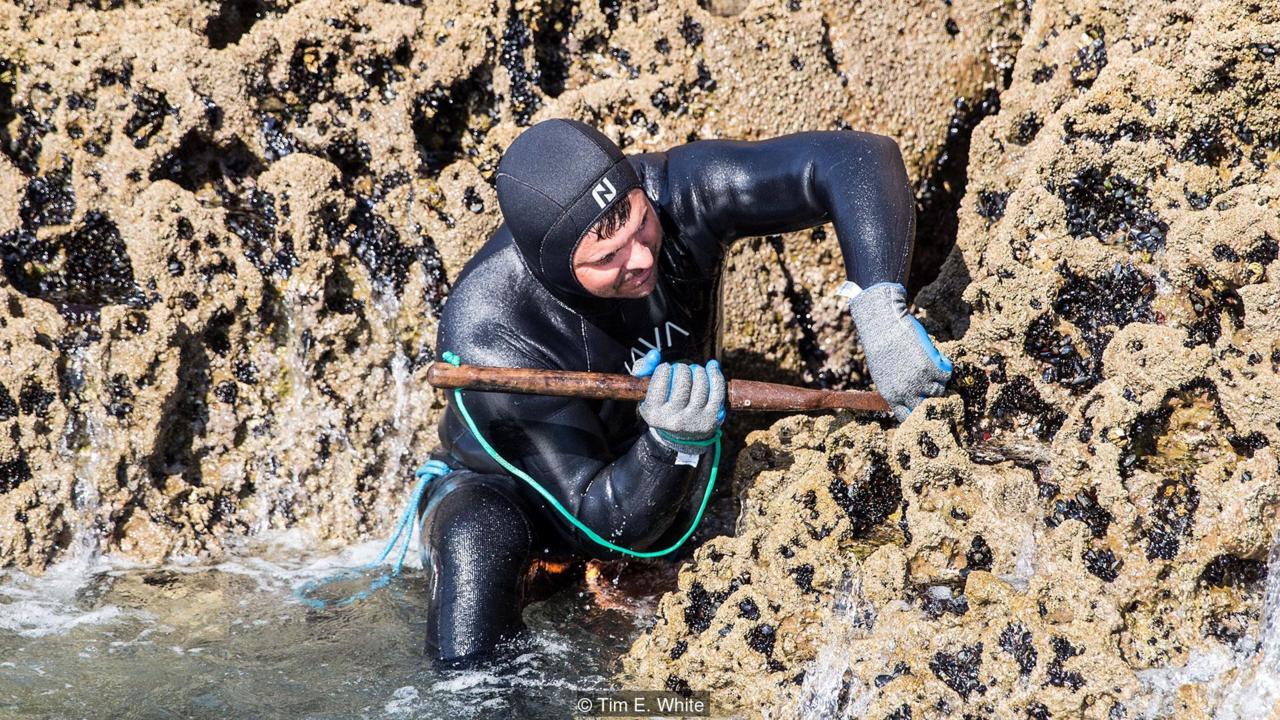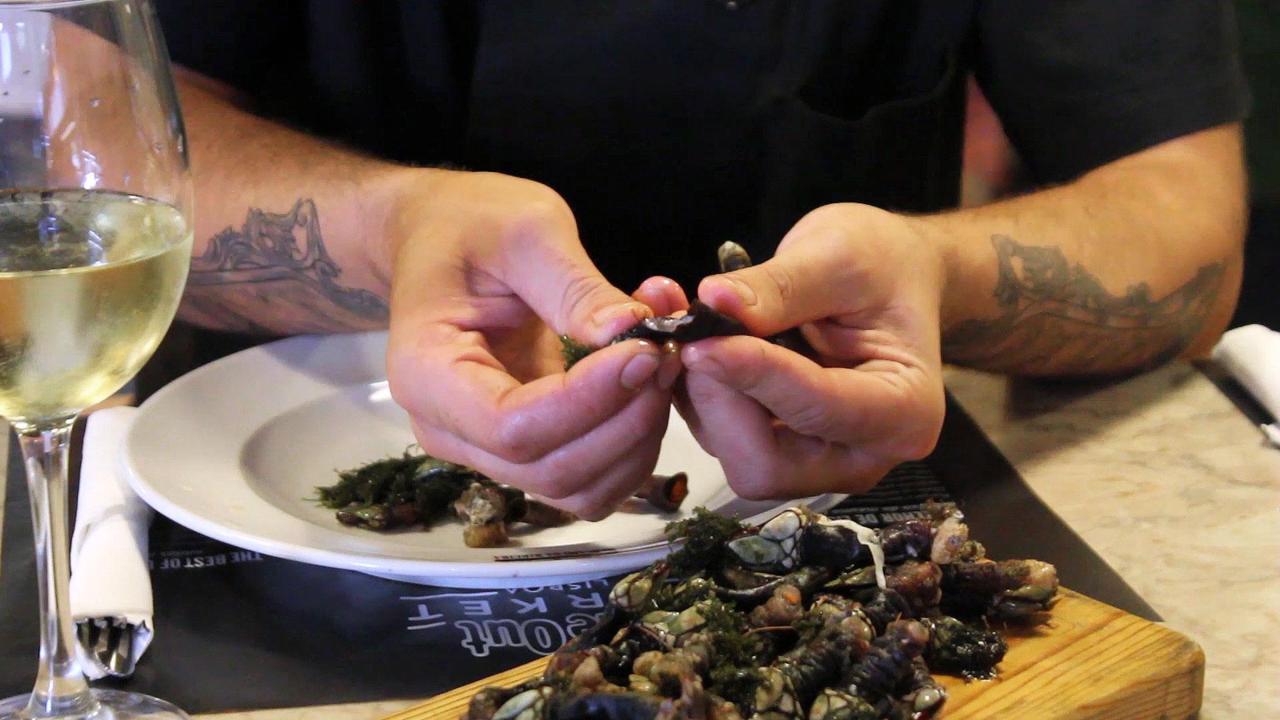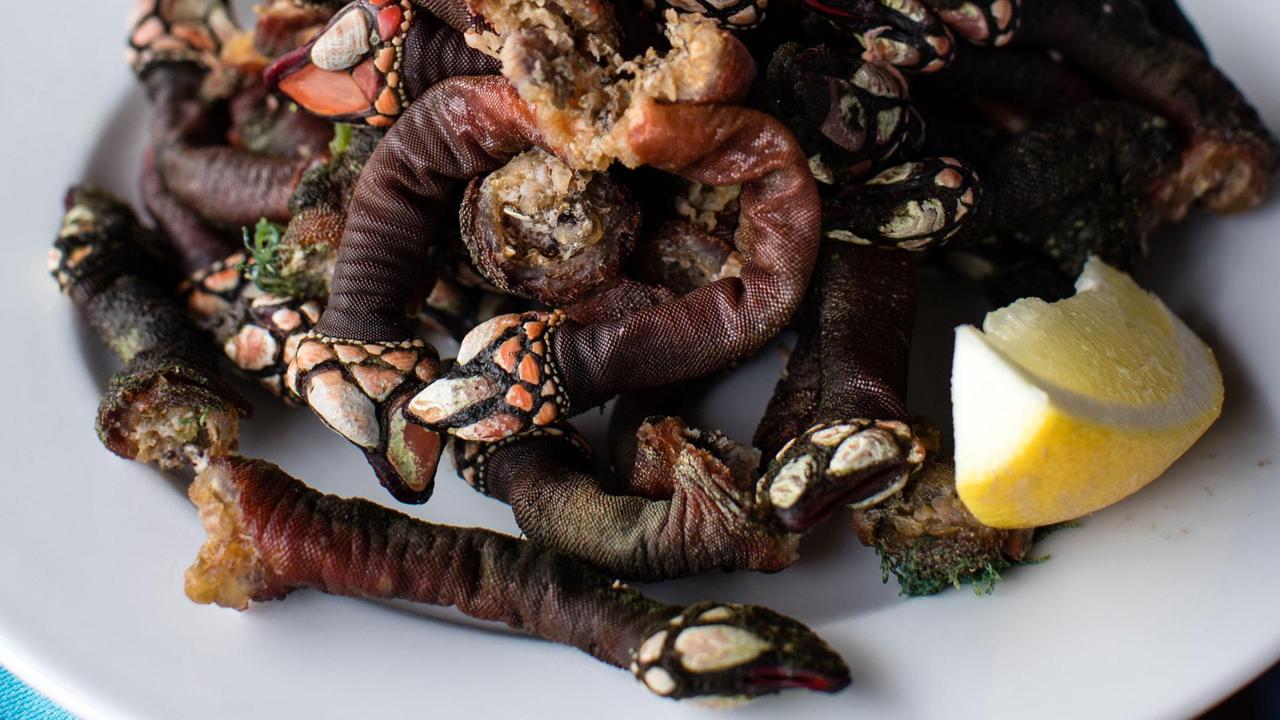In search of ‘Lucifer’s fingers’
To understand why a restaurant charged me €100 for a plate of percebes – tube-shaped, gooseneck barnacles known in Portugal as ‘Lucifer’s fingers’ – I spent a day with the brave men who risk life and limb to harvest them from the country’s most south-western coastline, the Costa Vicentina.
Likened to the devil’s digits because of their thick, finger-like trunks and diamond-shaped ‘feet’ that are eerily similar to claws, percebes can only grow and multiply on rocks in the ocean intertidal zone (the area between the high and low water mark), where crashing waves feed them with plankton. They cannot be farmed, and the rough sea makes it notoriously dangerous for divers to harvest them. While gooseneck barnacles can be found in other parts of the world such as Canada, they are considered a rare delicacy in Spain and Portugal. (Credit: Tim E. White)
A day in the office
Because of the culinary and monetary riches these filter-feeding ‘truffles of the sea’ (as they are sometimes called locally) offer at market, divers make the most of any bout of milder weather to hunt for them.
“Even a bad day on the sea is better than a good day in the office,” said Fernando Damas (pictured), a percebes diver who quit his lucrative career as an industrial designer 19 years ago to dive for percebes full time. “The ocean is full of wonderful surprises.” (Credit: Tim E. White)
A dangerous business
On the Costa Vicentina, the saying goes: “Never turn your back on God when you dive for Lucifer’s fingers.” João Rosário, a commercial diver explains that, in this case, God refers to the might of the sea. “When you dive for percebes and you turn your back on the unpredictability of the ocean, you will most likely be injured or killed,” he said. “There are many cases of divers being knocked unconscious and drowning. The ‘lucky ones’ get away with breaking an arm or leg or suffering abrasions where the rocks cut through their wetsuits.” (Credit: Tim E. White)
Different schools of thought
Percebes can be reached by climbing down the cliffs or diving from a boat. There’s little consensus over which technique is the least dangerous. Those who climb down 100m cliffs by rope to chisel the barnacles off the cliff face at low tide run the risk of a fall or being crushed against rocks by the breaking waves. The alternative is to anchor a safe distance from the cliffs when the tide is slightly higher, and then swim towards the cliff face, timing each effort to chisel off the percebes to the rhythm of the ocean. (Credit: Tim E. White)
The necessity of teamwork
Percebes divers work in pairs for safety reasons, and you need to trust your partner with your life, said Damas, who has been diving with his younger diving partner Tiago Craca for more than six years. They make a perfect team, sharing decisions on when it is safe enough to go out to dive and when to call it a day.
“He is half my age and has already saved my life,” Damas said. “That day, my head was full of other thoughts. You can’t be worrying about things – it’s dangerous if you lose focus. I did not see a large swell and my foot got stuck in a crevice. Luckily Tiago realised that I’d been underwater too long and came looking for me.” (Credit: Tim E. White)
A regulated industry
In Portugal, percebes hunting is highly regulated, and all diving activities are controlled from the town of Villa do Bispo (pictured), home to the Associacao Dos Marisqueiros Da Vila Do Bispo, Portugal’s percebes association. Only 80 diving licenses are issued each year, with most of the divers living here or in the nearby coastal town of Sagres. The local fish market in Sagres is the only place where divers are legally allowed to sell the barnacles to restaurant owners and suppliers. The daily harvest is restricted to 15kg per diver, with prices reaching between €30 and €60/kg depending on the quality and size of the percebes, according to Paulo Barata, president of the association. (Credit: Tim E. White)
‘Our ATM in the sea’
Despite strict regulations, the poaching of percebes remains rife; it’s a lucrative business and the marine police cannot patrol everywhere. It’s also a secretive business, and not even the licensed divers share where they have dived or plan to dive next because of the rarity of the delicacy.
One poacher at the fish market in the coastal town of Portimão, 55km east of Sagres, spoke his mind: “I don’t care about the rules. The Costa Vicentina belongs to the people – not the government. The percebes are our ATM in the sea. We have the right to withdraw our money.” (Credit: Tim E. White)
No cutlery required
It’s fair to ask what all the fuss is about; but tasting percebes more than answers the question. Imagine a lazy afternoon on a beach holiday: the sun is starting to set and a light breeze ushers in the scent of the ocean. That’s the taste of percebes.
And there’s only one way to eat the devil’s fingers – with your own fingers, said Sergio Meudes, manager at Marisqueira Azul restaurant in Lisbon, where percebes appear on the menu when available. You need to firmly grab hold of the colourful claw of the barnacle and then rip the fleshy meat from the rubbery neck. “The next part is easy – eat it!” he said. (Credit: Tim E. White)
Only one way to prepare
There’s an overwhelming consensus among the Portuguese that there’s only one way to cook percebes properly: in boiling salted water for no longer than it takes to say the Lord’s Prayer. “Even if you pray slowly, it should never take more than a minute,” said Adriano Lemes, Marisqueira Azul’s chef. “Then spoon it onto ice to terminate the cooking process. Don’t add any spices and especially not any sauce,” he stressed.
And don’t dare mention the fact that British celebrity chef Gordon Ramsay once served percebes in a creamy sauce. The locals within earshot will throw their arms in the air and shout out sayings such as ‘falando como um verdadeiro idiota’, which is loosely translated as, “what an idiot!” (Credit: Tim E. White)
Article written by BBC Travel









